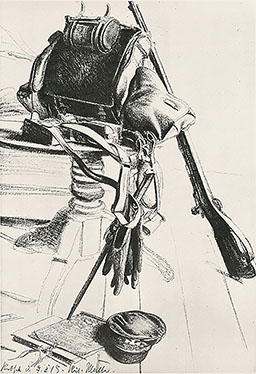In 1914, only a few weeks after the beginning of World War I, Richard Müller was called to military service. In contrast to many others of his generation, he followed this command without any enthusiasm or delusions whatsoever. The professor of the academy was spared from armed service, however; he was instead placed on the sidelines, in the shadows of the Western Front, to record in his drawings the grim remnants and general destruction from the battles.
After his early withdrawal from military service in 1915, Müller self-published a portfolio with 40 etchings of these war memories, From the West, and dedicated it to Prince Johann Georg of Saxony. The profits from this print collection went directly to the benefit of the Central Committee of the Red Cross. On the last sheet of this series, Müller depicted his own luggage (Fig. 1), which, besides a knapsack and a rifle, held drawing portfolios and pens. In the drawing, these objects lie on the wooden floor next to the artist‘s peaked cap, which apparently replaced a helmet since Müller was the draftsman in the shadows of the battle lines. Another striking drawing from the bundle of approximately 200 war sheets, which he collectively prepared from behind the Western Front in Flanders and France, is this portrayal of Burned-Out Houses in Givonne, a community in the French Ardennes, not far from Sedan. Müller presented the skeletonized architecture here with an easy control and abstracting simplification, which was contrary to his usual rigid realism, yet offered him the possibility of juxtaposing different structures simultaneously. As with many other sheets in the series, this deserted view imparts even to present-day viewers a sense of death, which Müller must have felt at the time.

